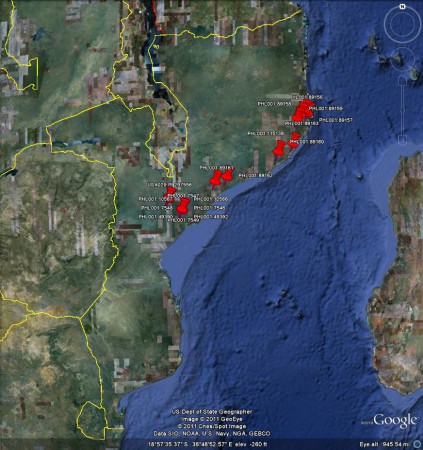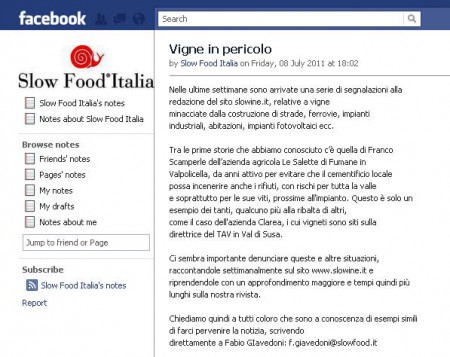- The risks of success in quality vegetable markets: Possible genetic erosion in Marmande tomatoes (Solanum lycopersicum L.) and consumer dissatisfaction. Market takes the fun out of landraces.
- Genetic variability of root peel thickness and its influence in extractable starch from cassava (Manihot esculenta Crantz) roots. Starch content depends on dry matter content and peel thickness. About 1500 accessions from CIAT evaluated for the latter, so lots to play around with.
- A meta-analysis of crop pest and natural enemy response to landscape complexity. More landscape complexity means more natural enemies. Still no cure for cancer.
- American Chestnut past and future: Implications of restoration for resource pulses and consumer populations of eastern U.S. forests. Reintroduction of blight-resistant chestnut may have some weird effects on other species.
- Keep collecting: accurate species distribution modelling requires more collections than previously thought. Oh damn.
- Variation in seed dormancy quantitative trait loci in Arabidopsis thaliana originating from one site. Is due to two QTLs. Also flowering time. But no, I don’t understand that “In contrast…” at the end of the abstract either.
- Tracking origins of invasive herbivores through herbaria and archival DNA: the case of the horse-chestnut leaf miner. Another use for old herbarium specimens: finding evidence of pests.
- Animal breeding in India – a time for reflection, and action. The reflection is that genetic improvement has stagnated, so the action needed includes better phenotypic record keeping, more attention to local diversity and community-breeding programmes.
- Performance of micropropagation-induced off-type of East African highland banana (Musa AAA – East Africa). A promising avenue for improvement, the off-types yield more better bananas, a month later.
- Pollination services in the UK: How important are honeybees? Not as important as you might think!
- The same regulatory point mutation changed seed-dispersal structures in evolution and domestication. Cabbage-family fruit development and rice shattering share the same single point mutation.
- Participatory research and on-farm management of agricultural biodiversity in Europe. By Michel “Pimpert”. That should be Pimbert. Old news, but worth mentioning.
A call for information on threatened Italian vineyards
I suppose there’s some poetic meaning to the coincidence that it is while I’m travelling in the oldest wine-producing region of the world that I notice on Facebook a call from Slow Food Italia for information on vineyards threatened with destruction. Be that as it may, it will be interesting to see what response Slow Food get, and what use they make of it. We have blogged here on various occasions about the desirability of an early warning system for genetic erosion, and how one might go about setting one up. This might have the makings of one, at least for grapevine in Italy.
Brainfood: Medic systematics, Fruit wine, Alfa paper, Marula diversity, Cardamon pollination, Protein, Ants, Peanuts, Truffles, Ethiopian barley, Citrus diversity, Biofuel trees, Honeybush, Czech garlic
- Genetic similarity based on isoenzyme banding pattern among fifty species of Medicago representing eight sections (Fabaceae). People are still using isozymes? I find that oddly endearing.
- Preparation and evaluation of antioxidant capacity of Jackfruit (Artocarpus heterophyllus Lam.) wine and its protective role against radiation induced DNA damage. In other news, you can make wine from jackfruit.
- Pulping and papermaking properties of Tunisian Alfa stems (Stipa tenacissima)—Effects of refining process. Yep, a paper on paper.
- Phenotypic variations in fruits and selection potential in Sclerocarya birrea subsp. birrea. There’s a lot of it.
- Pollination studies in large cardamom (Amomum subulatum Roxb.) of Sikkim Himalayan region of India. It needs a native bumblebee.
- Effect of proteins from different sources on body composition. Hard to be sure, but probably no difference between animal and plant protein. If you’re trying to lose weight, that is.
- Ants as biological control agents in agricultural cropping systems. More common than you think, but can’t be taken for granted.
- Origin of triploid Arachis pintoi (Leguminosae) by autopolyploidy evidenced by FISH and meiotic behaviour. Maybe that was they key step on the road to the edible peanut.
- The biochemistry and biological properties of the world’s most expensive underground edible mushroom: Truffles. Not just a pretty smell.
- Ethnobotany, diverse food uses, claimed health benefits and implications on conservation of barley landraces in North Eastern Ethiopia highlands. Landraces “just” liked for culinary qualities are having a hard time.
- Comparative analysis of genetic diversity in Citrus germplasm collection using AFLP, SSAP, SAMPL and SSR markers. Boys with toys.
- Tree legumes as feedstock for sustainable biofuel production: Opportunities and challenges. Pongamia pinnata is the thing, apparently, but it’ll need research. NIMBY!
- Honeybush (Cyclopia spp.): From local cottage industry to global markets — The catalytic and supporting role of research. South African bush tea a blueprint for the development of a neglected/underutilized species? Yeah, why not.
- Diversity of S-alk(en)yl cysteine sulphoxide content within a collection of garlic (Allium sativum L.) and its association with the morphological and genetic background assessed by AFLP. Czech genebank follows up Brassica genetic diversity study with one on garlic. SACS is an important end-use trait, and varies among genetic groups.
50% is the new 75%
Experts estimate that we have lost more than half of the world’s food varieties over the past century.
The future of rice in Mozambique
Readers with long memories who had time on their hands back in January may remember a post we did then on IR80482-64-3-3-3, a new rice tailor-made for Mozambique. There was some discussion at the time about the claims being made in the original SciDevNet piece about the new variety on which we based our post, but what really struck me was this statement:
Work began when the International Rice Research Institute (IRRI), in the Philippines, sent Mozambique 11,200 rice varieties for testing.
That just sounded like quite a lot of varieties, and I remember wondering at the time how long it took the Mozambique national rice programme to get through that little lot. But anyway, I bring this up now not only because someone from IRRI has very kindly left a comment on the original post. But also because IR80482-64-3-3-3 is back in the news, cannily renamed Makassane. The IRRI press release has been widely picked up.
Following the approval of Makassane for release by the Mozambique Variety Release Committee earlier this month, IRRI provided government agencies and farmers “foundation seed” to use in bulking up the seed so that more can be produced and distributed to more farmers.
 Two things about this. First, I look forward to regular updates on Makassane’s uptake by farmers. And second, I hope the IRRI and Mozambique national genebanks are confident that they already have good representation of the local landraces. Sophie, who left the aforementioned comment, says there are 76 rice types from Mozambique at IRRI. Genesys gives us just over 120 worldwide, between landraces and wild species, but only a few are geo-referenced (see map).
Two things about this. First, I look forward to regular updates on Makassane’s uptake by farmers. And second, I hope the IRRI and Mozambique national genebanks are confident that they already have good representation of the local landraces. Sophie, who left the aforementioned comment, says there are 76 rice types from Mozambique at IRRI. Genesys gives us just over 120 worldwide, between landraces and wild species, but only a few are geo-referenced (see map).
